January was just coming away from its third cold front where some Valley night temperatures reached the danger zone– those dastardly frost and freeze degrees — yet the days, even though cold, gray and windy, witnessed flights of butterflies, the sight of which caused me to wonder what they were finding for nourishment.
After weeks of dismal weather, we had a pleasant early morning, and I resumed my daily wanderings around the grounds. I was amazed to find twin blooms on a perky West Indian lantana, Lantana camara, described on page 415 in the Richardson and King book, “Plants of Deep South Texas,” (PDST)at the back of our property. And next to it, the neon-bright violet of out-of-season blooms on Crucita, Chromolaena odorata, page 91.
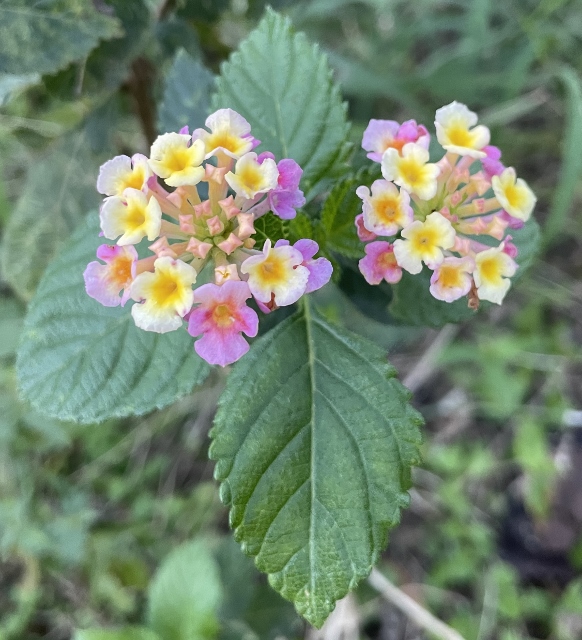
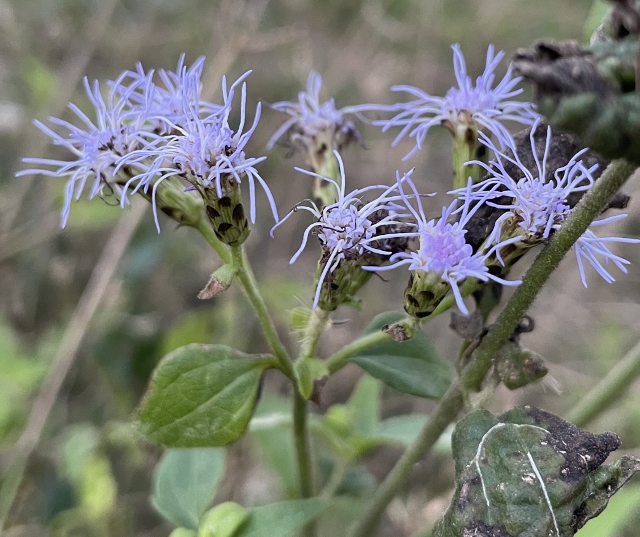
The rest of my stroll became a hunt for as many blooming plants as I could find. I wasn’t disappointed. I’ve listed them below, for those who might be considering adding to their nectar gardens during the Valley’s optimum planting time — when temps are cool and plants won’t be stressed from drought and summer’s heat. The numbers refer to the page number in PDST.
Scarlet sage, Salvia coccinea, 288; yellow sophora, Sophora tomentosa var. occidentalis, 270; snapdragon vine, Maurandya antirrhiniflora, 387; Texas lantana, Lantana texana 415; low croton, Croton humilis, 217, also called dove croton — an excellent nectar source; iNaturalist.org uses the common name pepperbush.
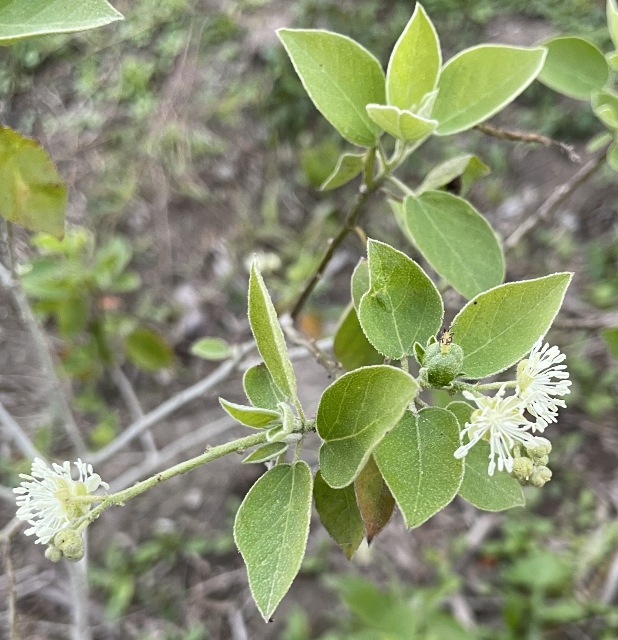
Mexican hat, Ratibida columnifera, 121; Mexican capraria, Capraria Mexicana, 385; Alamo vine, Merremia dissecta,198; Turk’s cap, Malvaviscus drummondii, 313; scorpion’s tail, Heliotropium angiospermum, 144; skeleton leaf golden eye, Viguiera stenoloba, 135; and frost weed, Verbesina microptera, 134.
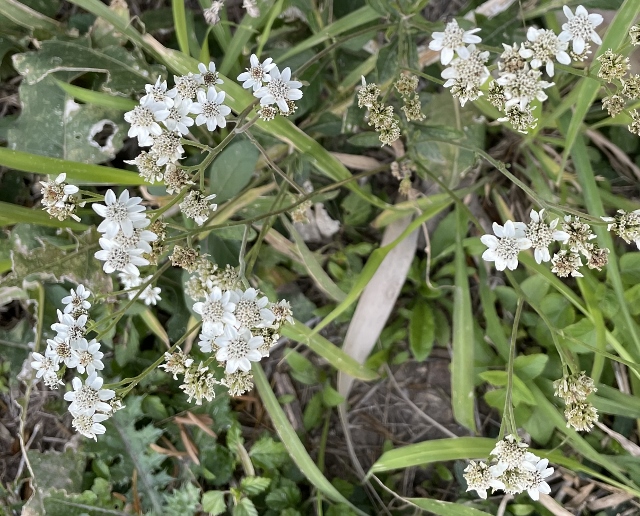
Seaside goldenrod, Solidago sempervirens, 125 — if you’re familiar with the U.S. Marine Corps, you’ll know that semper is Latin for always. Virens in Latin translates to vigorous. This is a new addition to my garden.
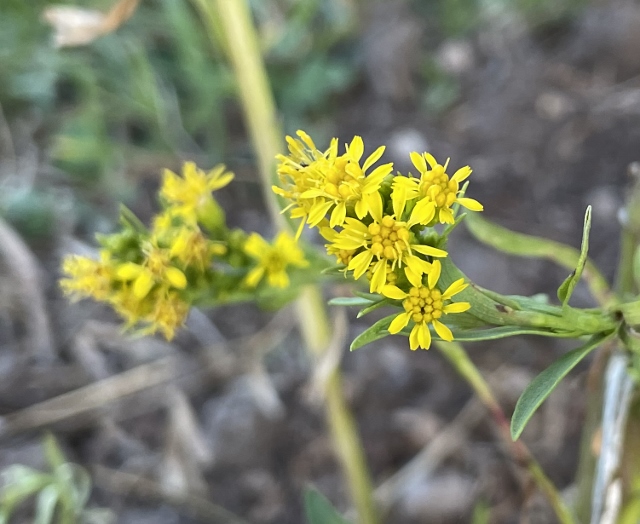
Pink mint, Stachys drummondii, 291 — generally the first to bloom after a very harsh winter; and fiddle leaf tobacco, Nicotiana repanda, 396, rounded up my blooming native plants.
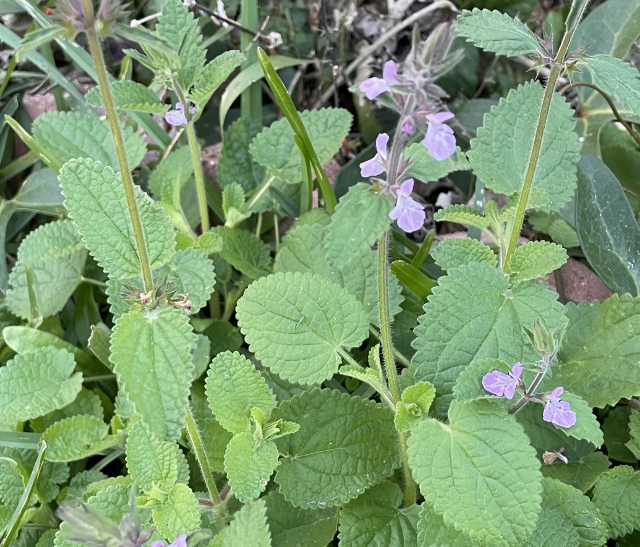
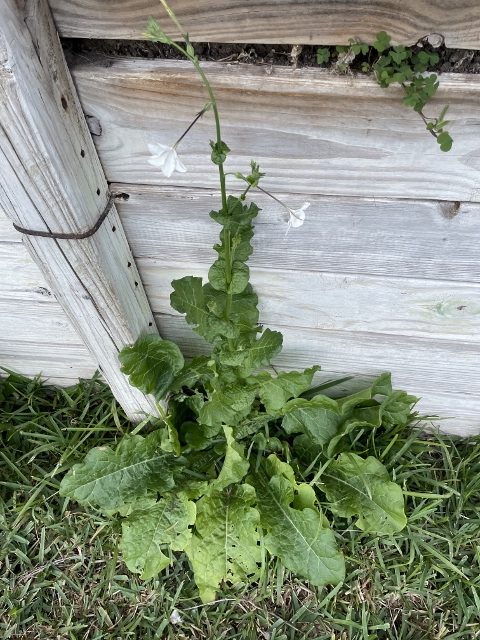
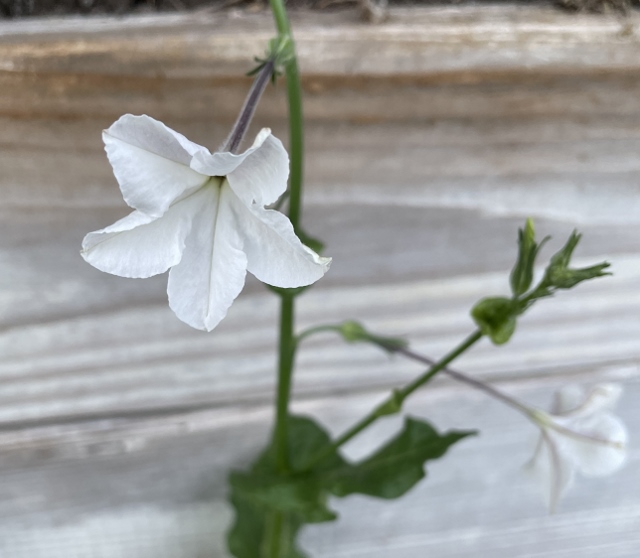
I haven’t discussed fiddle leaf tobacco in this blog, primarily because I never seem to get a good enough photo of it. What’s significant now is that the bloom period, according to PDST, is spring, summer and fall and here it is January; it has not only pushed out its huge symmetrical rosette of rippled green leaves, it has shot up a stem and produced blooms
Fiddle leaf tobacco is an annual plant. Annuals, if you recall, are those plants that perform their entire life cycle from seed to flower within a single growing season and all roots, stems and leaves of the plant die annually.
The species name, repanda, comes from the Latin word repandus which means, turned up, referring to the leaf margins, what I described as rippled.
Plants.usda.gov annotates that fiddle leaf tobacco is native in Texas and Alabama. It is a nightshade in the Solanaceae family (Potato family). It grows in full sun to partial shade.
The leaves are huge compared to most Valley native plant leaves — they can reach to 12 inches long. The flower stem of fiddle leaf tobacco can reach to 18 inches or taller and the rosette 12 inches or more in diameter. The following photos show it in the taller and more than measurement categories where the new rosette reaches to nearly both ends of the yardstick. The stalk in the other photo reaches to two feet, the blooming stems pushing past the top of the yard stick.
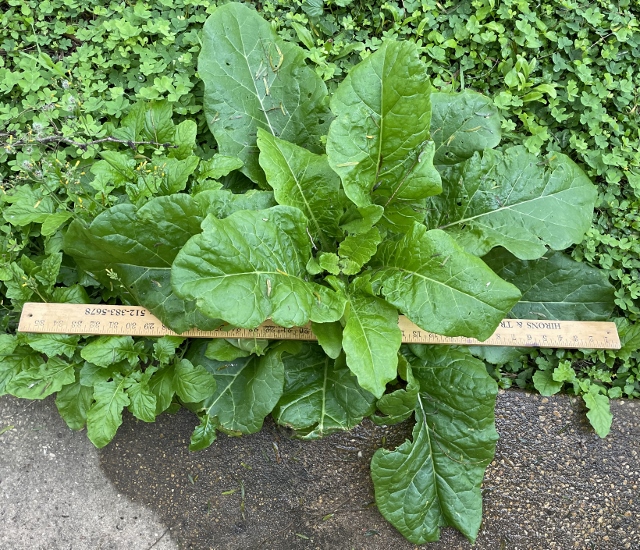
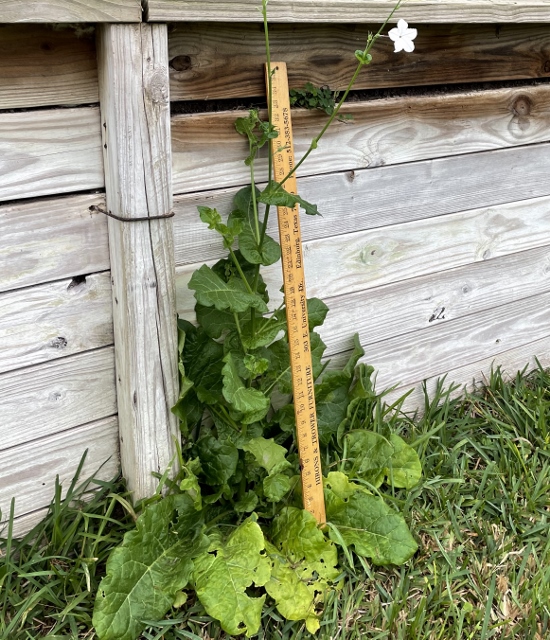
All parts of fiddle leaf tobacco — leaves, fruit and roots, are poisonous if ingested. Be advised, this plant is not the commercial cultivar grown for the cigarette industry. The flower, according to one site, is attractive to bees, butterflies, birds, hummingbirds and various insects, although I don’t recall having seen any visitors to the plants on our property.
One source says that the seeds, which can be collected in the fall, need 73 degrees F. in order to sprout. The plant certainly self-propagates on our land without those temperatures as witnessed by the new plants in the photos. Other observances I have made are that in partial shade, and on cloudy days, the blooms stay open during the day, although most websites say that the flowers open in the evening.
I’ve certainly not noticed this plant being particularly busy and that may be because it is a night/low-light bloomer and is perhaps visited by moths after the sun goes down. It’s a unique native plant that causes no harm, and I leave it to thrive in the sheltered areas of the yard. Last year, a fiddle leaf tobacco plant sneaked out from between the slats in one of the retaining walls. I left it, just for fun. Noting its progress entertained me during rounds with the lawn mower. By June, it was quite something.
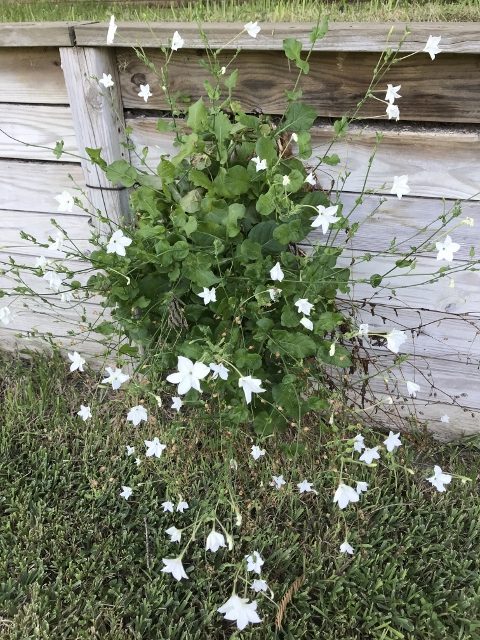
Dr. Alfred Richardson and Ken King, in their book, “Plants of Deep South Texas,” caution us about plants in the solanaceae family. Under the comments on page 401 about the Tomato, Solanum lycopersicum, they write: “While this plant and other tomatoes, potatoes, and eggplants are edible members of the Solanaceae family, it must be remembered that the deadly nightshade (Atropa belladonna) is in this same family.” Belladonna is native to Europe, North Africa and Western Asia and has escaped to some American states. I won’t address it here; information is available on the Internet for those who may be curious.
For more about our edible wild tomato plant described on page 401, Solanum lycopersicum [Lycopersicon esculentum var. cerastiforme], please see a previous blog post at: https://rgvctmn.org/blog/anitas-blog-a-bit-on-the-wild-side/
Another plant in the Solanaceae family, one that produces the edible but fiery berries of chile piquin, Capsicum annuum var. avicular, page 391, is currently blooming and popular with both humans, mockingbirds — and other berry eating birds.
Three native but not edible, plants in the Solanaceae family are noted below:
The potato tree, Solanum erianthum, 401. This fast-growing shrub/small tree is popular in butterfly gardens throughout the Valley. It’s one of the busiest and more entertaining trees in a garden: https://rgvctmn.org/blog/anitas-blog-consider-the-potato-tree/
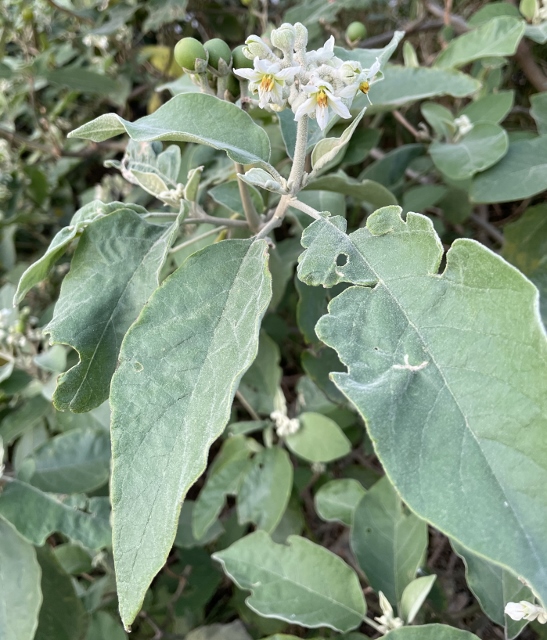
Two local and prevalent nightshades: Silver leaf nightshade, Solanum eleagnifolium, 400, provides nectar for butterflies, the seeds are eaten by bobwhite quail; and Texas nightshade, Solanum triquetrum, 403, the fruits of which are eaten by several species of songbirds; the flowers are visited in the summer by tiny fly-like insects.
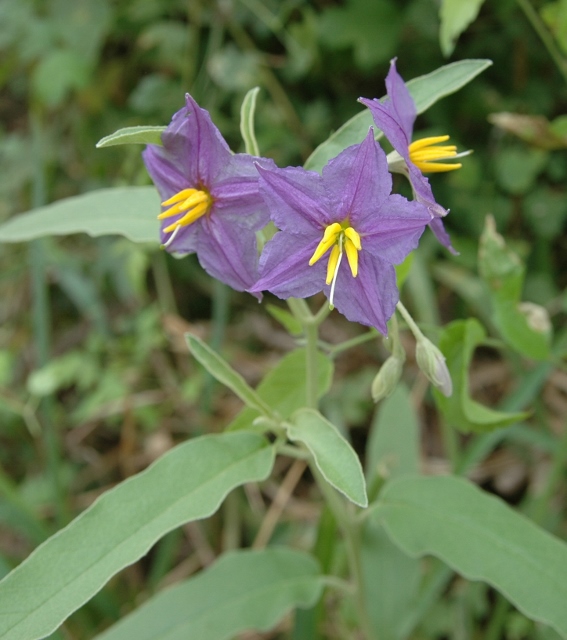
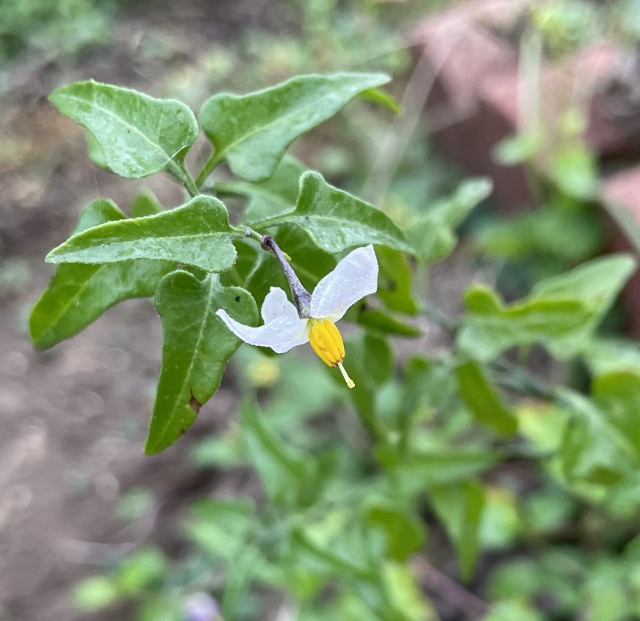
In other news!
Consider looking for blooming and non-blooming plants in your own areas — and the critters that use them — in advance of the annual City Nature Challenge 2021 which is just around the corner.
Participation is encouraged and open to all Valley residents and Winter Texans.
Mark these dates:
Friday, April 30 – Monday, May 3, 2021 for taking pictures;
Tuesday, May 4 – Sunday, May 9, 2021 for ensuring photos are uploaded and identified. For more information, visit: https://citynaturechallenge.org/
Please note: Cameron, Hidalgo, Starr and Willacy counties enter as a single entity: Lower Rio Grande Valley.
This will be the fourth year the Valley has participated in the challenge. Our local area coordinator is Urban Ecologist John Brush, a valued advocate and friend of our two Valley Texas Master Naturalist chapters and long-time member of McAllen’s Quinta Mazatlán staff.
This is a global event with dynamic sponsors like California Academy of Sciences, Natural History Museum, Center for Urban Ecology, Nature Trackers, Texas Parks and Wildlife, a multitude of local sponsors worldwide; local sponsors include Texas Master Naturalists and Quinta Mazatlán.
A coordinated effort has already begun via a virtual training session which introduced students in the two new TMN training classes with the value of participating in this event from both a personal level and a globally scientific level.
Since 2018, Anita’s Blog has included instructional information about the challenge. Those blog posts still carry valid information — the 2021 dates are different from former years. The iNaturalist phone app is a bit different than described in the earlier blog posts but is even more user friendly and self-explanatory.
Last year’s challenge was during the early months of the pandemic; without knowing the future, this year’s challenge may also take place while the world is following governmental safety guidelines. Our area coordinator will be working with the state, our TMN chapters, partners, nature preserves and parks and others about possible iNaturalist training events. That information will be forthcoming.
In the meantime, take a look through some of the former instructional blog posts:
2018 — https://rgvctmn.org/blog/anitas-blog-the-great-valley-challenge-of-2018/
2019 — https://rgvctmn.org/blog/anitas-blog-training-for-the-challenge/
And https://rgvctmn.org/blog/anitas-blog-take-your-best-shot/ — This post offers a list of photo tips suggested by local identifiers to help observers to photograph the best possible specimens which in turn will help get species identified more easily.
2020 — City Nature Challenge information begins after the last photo at: https://rgvctmn.org/blog/anitas-blog-bee-funny-bee-friendly/